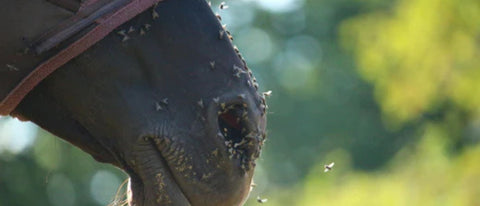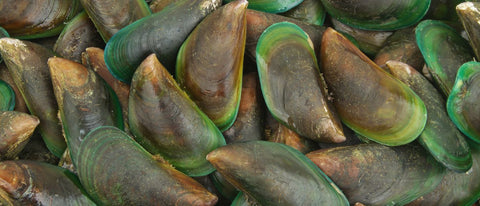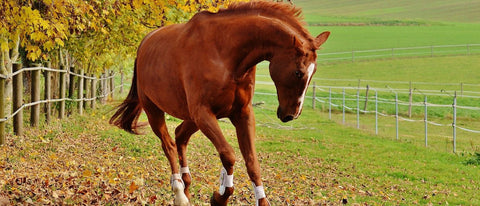
Florian ist aufgewachsen auf einem Bauernhof. Umgeben von Pferden, entdeckte er früh seine Faszination für diese majestätischen Tiere. Inspiriert von seiner reitbegeisterten Mutter, entwickelte er das Nahrungsergänzungmittel - Pferdegold. Seine tiefe Verbundenheit zur Natur und die leidenschaftliche Hingabe zu Pferden trieben ihn an, sein Unternehmen zu gründen.
Summertime also means horsefly season in many regions. In certain areas, horsefly infestations can occur, which is particularly stressful for horses. Their sensitive skin reacts immediately to attacks from these insects.
Why is horsefly bite so painful? Unlike many other insects, horseflies don't use fine stingers to sting, but rather their powerful mouthparts to pierce the skin. This creates a relatively large wound, which significantly increases the pain.
In regions where horseflies are particularly common, this can cause considerable stress and discomfort for horses, as they can hardly rest due to the constant attacks of the insects.

Summertime is brake time
Summer is peak horsefly season in many places. These nasty pests pester horses until they bleed. Blood, which they then donate to their potential offspring – 400 to 1,000 elongated white eggs. Only the females suck their eggs, while the males prefer to stick to plant sap and nectar.
There are more than 3,500 different horsefly species worldwide. They live in Europe, North Africa, and Asia. These insects belong to the order Diptera and the suborder Flies. The horsefly (Tabanus sudeticus) is the largest of the horseflies—it measures between 1.9 and 2.5 cm in length.
Visually, these flying parasites resemble houseflies. The difference between horseflies and houseflies is that horseflies are usually somewhat longer and narrower. They also have wasp-like gray and brown stripes on their abdomens. Horseflies are also called
- Blind fly,
- Blind cuckoo,
- Dase
- or called Bräme/Brämer.
This species of horsefly is primarily active between April and August. The insects' activity increases particularly in warm, humid weather, as they search more intensively for a blood source. In such conditions, horsefly bites often occur quickly.
But how do vampires actually detect their victims? With the help of their antennae. These miniature detectors detect chemicals in sweat and breath, as well as body heat. This works even over great distances, so both humans and horses can become victims of horseflies.

Pferdegold® horsefly spray
Our extra-strong horsefly spray contains a plant-based active ingredient that is extremely powerful and long-lasting – against horseflies as well as flies, ticks, mosquitoes, and other biting insects.
Order nowSymptoms and treatment of horsefly bites
Horsefly bites in horses are generally more painful than mosquito bites, and the symptoms are more severe. Appropriate treatment is therefore particularly important to avoid potential complications.Symptoms
Horsefly bites in horses are generally more painful than mosquito bites, and the symptoms are more severe. Appropriate treatment is therefore particularly important to avoid possible complications. The bite site is immediately noticeable and can cause severe pain and a burning sensation. This is often followed by
- redness and swelling,
- followed by itching.
In rare cases, inflammation, blistering, or an allergic reaction may occur, with symptoms such as increased swelling, rash, or difficulty breathing.
Horses with sensitive skin are particularly sensitive to horsefly bites and may become restless or even aggressive in such cases. It is important for horses to detect and treat bites early, as they may experience additional discomfort from the increased scratching and rubbing. There is no definitive evidence that horseflies transmit Lyme disease; this occurs primarily through ticks.
Early cooling of the affected area and the application of anti-inflammatory ointments can help relieve symptoms. In case of an allergic reaction or persistent swelling, a veterinarian should be consulted to ensure the horse's well-being.
Treatment of horsefly bites
If your horse has been bitten by a horsefly, it's important to act quickly to support your horse's well-being. Cooling the affected area can provide quick relief.
-
Use special cooling gels that are suitable for horses, or cool the area with a gentle jet of water , for example from a hose.
-
I also like to use aloe vera, acetic clay , and similar natural remedies.
-
Natural cooling methods using herbs can also have beneficial effects. A cooled herbal decoction of chamomile or parsley can soothe the skin and promote well-being.
- Acetic clay can help reduce swelling and minor irritation. A curd compress has cooling properties, while aloe vera is known for its nourishing effects on irritated skin.
Comparison of repellents
To protect horse and rider from annoying horseflies and other insects, so-called repellents are often used . These repellents help prevent insect bites and increase well-being during rides. There are both natural and chemical repellents that can be used as needed.

Pferdegold® horsefly spray
Our extra-strong horsefly spray contains a plant-based active ingredient that is extremely powerful and long-lasting – against horseflies as well as flies, ticks, mosquitoes, and other biting insects.
Order nowNatural repellents for horses and riders
Natural repellents offer gentle protection and are especially suitable for horses sensitive to chemicals. Popular natural repellents include:
-
Lemon Eucalyptus Oil : This oil is a proven insect repellent and is often used to repel horseflies. It's a natural agent that can effectively protect not only riders but also horses. Its effects last up to six hours, making it a good option for shorter rides.
-
Lavender oil : Lavender oil not only has a pleasant scent, but also has a calming and insect-repelling effect. It is particularly gentle on the skin and can be applied to sensitive areas of horses, such as the nostrils and ears.
- Citronella oil : Citronella is best known for its mosquito repellent properties, but it also offers some protection against horseflies. However, because the effect is short-lived, it must be applied more frequently.
Chemical repellents: long-lasting protection for riders
For riders, chemical repellents are often more practical because they offer longer-lasting protection . These repellents contain specially developed active ingredients that reliably repel insects:
-
DEET : A highly effective repellent that keeps away insects such as horseflies, mosquitoes, and ticks. It can last up to ten hours, making it ideal for long rides. However, it can cause damage if it comes into contact with leather or certain fabrics, so it should be used with caution.
- Picaridin : A good alternative to DEET because it's just as effective against insects but doesn't damage clothing or equipment. It's also odorless and less irritating to the skin, making it especially convenient for riders.
Choosing the right repellent depends on individual needs and the duration of use . While natural repellents are well-suited for protecting horses and shorter rides, chemical repellents offer long-lasting protection for the rider.
Our product recommendation
Why some horses are more affected by horsefly bites
Some horses seem to have a magical attraction to horseflies, while others are less affected. The reasons for this are varied: factors such as
🐴 Skin texture,
🐴 Coat color
🐴 and body odor play a role.
Brake magnet: Black horses
Some horses , especially those with dark coats , are more frequently plagued by horsefly bites than lighter-colored animals. This is primarily because dark coats have a higher surface temperature.
Studies by a Hungarian research team have shown that horseflies are more likely to attack horses with dark coats because the higher temperature of the dark surface creates a microclimate in which the insects' wing muscles function better. This allows them to flee more quickly when the horse tries to ward off the pests.

Additionally, it appears that horseflies are generally attracted to heat , as they can operate more efficiently in such environments. Especially in summer, when exposed to direct sunlight, the coats of dark horses heat up considerably, making them attractive targets.
Light-colored horses, on the other hand, heat up less and are therefore less attractive to horseflies . Increased sweating at higher temperatures can also lead to dark horses being bitten more often, as sweat dilates the blood vessels, making it easier for the insects to reach the blood.
Role of CO2 emissions and body temperature
The role of CO2 emissions and body temperature in horsefly attraction is crucial. Blood-feeding insects such as horseflies use CO2 released through respiration as a guide to locate potential hosts. Horses that emit more CO2 due to their size, activity, or physiological differences are therefore more attractive to these insects.

Pferdegold® horsefly spray
Our extra-strong horsefly spray contains a plant-based active ingredient that is extremely powerful and long-lasting – against horseflies as well as flies, ticks, mosquitoes, and other biting insects.
Order nowAdditionally , body temperature plays a key role . Higher temperatures indicate the presence of a living host, causing horseflies to focus on it.
Horses with elevated body temperatures or those that radiate more heat through exercise are more likely to be affected by horsefly bites . So, if your horse has an elevated body temperature due to exercise, it may be more susceptible to horseflies.
Preventive measures: How to protect your horse from horseflies
There are various tools available to effectively protect your horse from horsefly bites. Fly masks and rugs provide a physical barrier.
- While the fly mask covers your horse’s head and neck and especially protects the eyes and ears,
- The fly sheet prevents horseflies from coming into direct contact with the skin. These sheets are made of lightweight, breathable material.
Since horseflies prefer humid environments, it's a good idea to locate the coop as far away from water sources as possible. Regular cleaning, such as removing manure and standing water, is crucial to minimize breeding grounds. Good air circulation in the coop is also helpful, as insects avoid drafty environments.
Natural repellents are easy to apply to the horse's skin, whether by rubbing or spraying. Regular use is recommended. For horses that don't like being sprayed, the repellent can also be applied to particularly sensitive areas using a cloth or sponge.
Alternative remedies and home remedies
Some horse owners feed their horses garlic to make them less attractive to insects from within. However, there are concerns about potential health side effects with long-term use. A better natural remedy may be neem oil. However, it's important to apply it diluted to avoid skin irritation.
Make your own brake protection spray
Materials and ingredients:
- Spray bottle (1 liter)
- Apple cider vinegar (1 cup)
- Water (1 cup)
- Essential oils (20 drops of lemon eucalyptus oil, 10 drops of lavender oil, and 10 drops of peppermint oil)
- measuring cup
- funnel

Pferdegold® horsefly spray
Our extra-strong horsefly spray contains a plant-based active ingredient that is extremely powerful and long-lasting – against horseflies as well as flies, ticks, mosquitoes, and other biting insects.
Order nowDirections:
-
Prepare the bottle: Clean the spray bottle thoroughly to ensure there are no residues that could impair its effectiveness.
-
Mix ingredients: Pour the cup of apple cider vinegar into the measuring cup and add one cup of water. Stir the mixture well. Now add the 40 drops of each oil and stir well again. It's important that the oils are evenly distributed.
-
Fill the spray bottle: Use a funnel to carefully pour the mixture into the spray bottle. Close the bottle tightly and shake well again to ensure all the ingredients are thoroughly mixed.
- Apply the spray: Spray the homemade horsefly repellent spray liberally on your horse, focusing on areas frequently attacked by horseflies (especially the legs, belly, and back). Repeat the application before every ride or every few hours to maintain the protection. This is especially important during heavy sweating or after contact with water.
Climatic and regional differences
The distribution and occurrence of horseflies depends heavily on climatic conditions , leading to significant regional differences. In Germany, which has a temperate climate, horseflies are primarily found in the summer months when it is warmer and more humid. Horseflies are particularly common near bodies of water and in agricultural regions.
In the wetter, warmer regions of Germany, such as the southwest, conditions are more favorable for horseflies, which can lead to a greater spread. In contrast, in cooler and drier regions, such as the higher elevations of the low mountain ranges, horsefly occurrence is rather limited.

Conclusion
Horseflies are particularly active between April and August and are known for their painful bites caused by their coarse mouthparts.
They are attracted to CO2, body heat, and dark colors, making them a nuisance to both humans and animals. Protective measures can include physical barriers, high levels of stable hygiene and air circulation, as well as chemical or natural repellents.
FAQ
What are horseflies good for?
Horseflies play an ecological role by serving as food for other animals (such as birds, frogs, and fish). They also contribute to the decomposition of organic matter.
What attracts horseflies?
Horseflies react quite strongly to horses, other large mammals, and even humans. They are attracted to dark colors, but especially to body heat and CO2 emissions.
When do horseflies bite humans?
Horseflies primarily bite humans during the daytime. They are attracted to CO2 emissions and warm surfaces, so people are especially at risk of being bitten by a horsefly during the day.
🐎 Learn more about horse health:
















